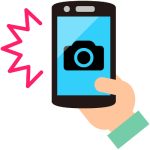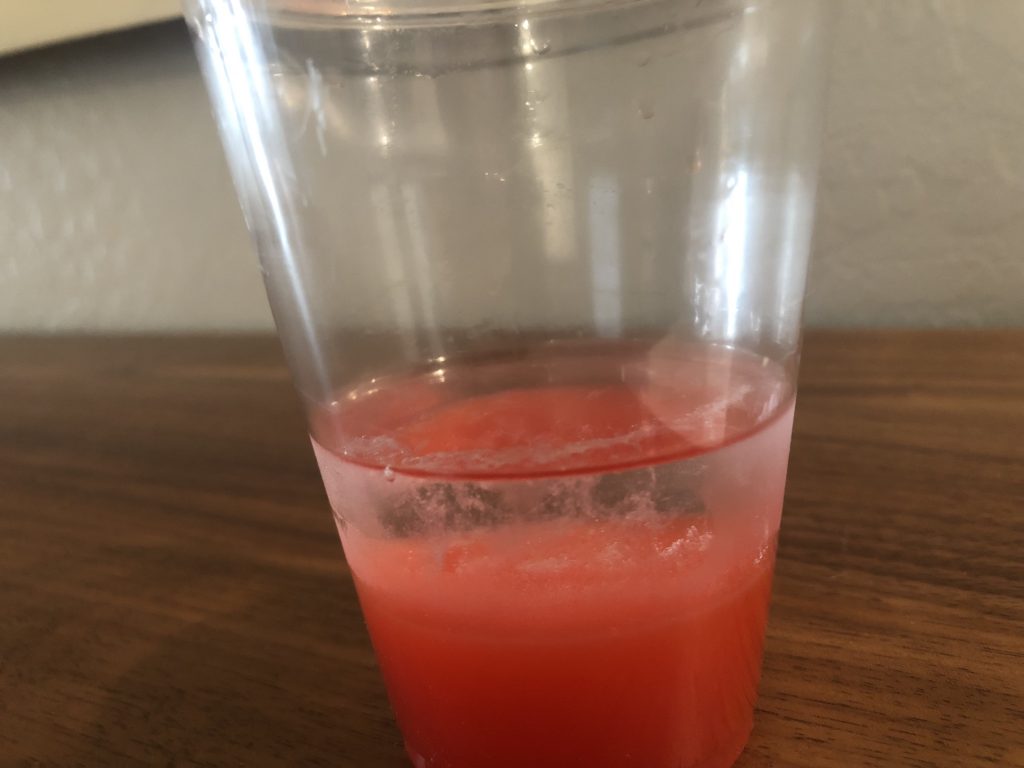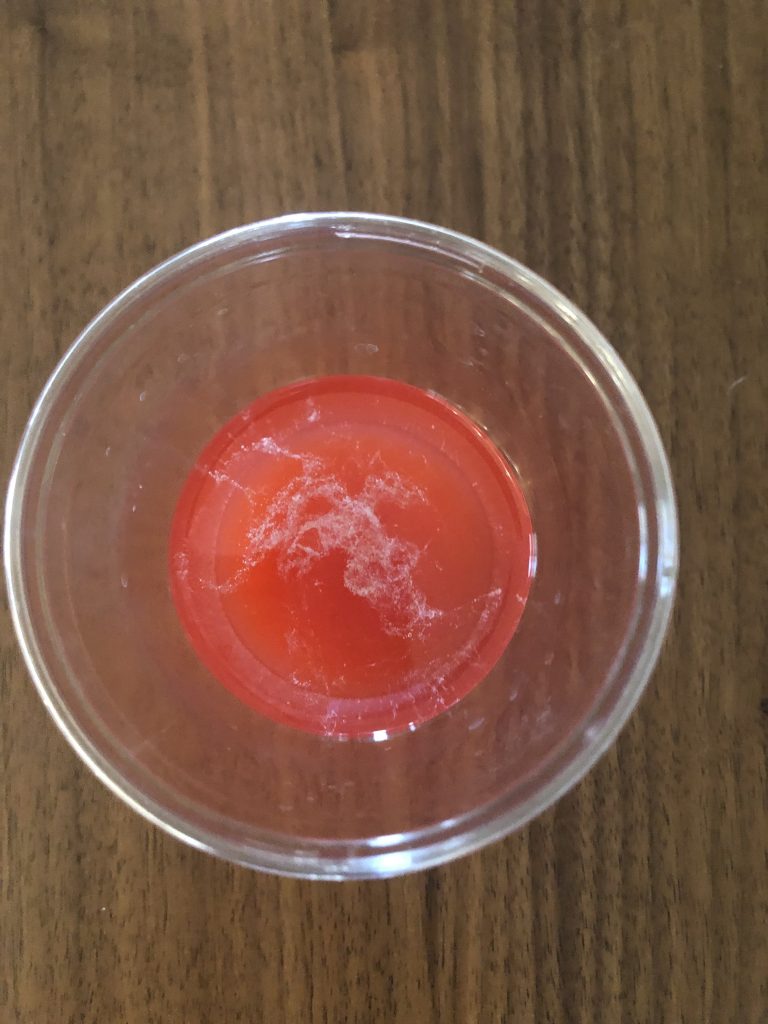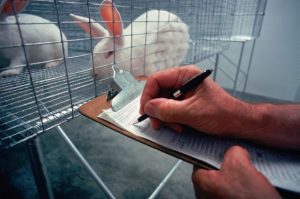DNA EXTRACTION
LEARNING OBJECTIVES
Extract DNA from plant cells.
Explain the purpose of each step in DNA extraction.
MCCCD OFFICIAL COURSE COMPETENCIES
Compare and contrast prokaryotic cell and eukaryotic cells.
Compare and contrast the physiology and biochemistry of the various groups of microorganisms.
NOTES
Strawberries yield more DNA than any other fruit because they are octoploid which means they have eight of each type of chromosome. Other fruit options include peeled kiwi, papaya, banana, and mango.
Store the isopropyl alcohol in the freezer for at least 60 minutes prior to use (overnight will produce significantly better results).
PHOTO REQUIREMENTS
Take a photo with your photo ID during the lab exercise when you see this icon.

Paste the photo into the DNA Extraction Questions Document.
introduction
Nucleic acids are one of the macromolecules of life along with carbohydrates, proteins, and lipids. Deoxyribonucleic acid (DNA) and ribonucleic acid (RNA) are nucleic acids. Like all macromolecules nucleic acids are made of building blocks or monomers. The monomer of nucleic acids is nucleotides. Nucleotides are composed of deoxyribose sugar, a phosphate group, and a nitrogenous base. There are four nitrogenous bases in DNA: adenine, guanine, cytosine and thymine. In DNA adenine pairs with thymine and cytosine pairs with guanine. DNA is a double stranded molecule that resembles a spiral staircase. The sides of the staircase are composed of deoxyribose and phosphate groups. Each step of the spiral staircase is made of two nitrogenous bases. DNA is present in every cell. In a prokaryotic cell DNA is located in the cytoplasm. In a eukaryotic cell DNA is located in the nucleus.
Flow of information from DNA–>RNA–>PROTEIN is the central dogma of biology. A dogma is a principle or set of principles laid down by an authority as incontrovertibly true. Flow of information in a cell explains how DNA becomes E. coli, a herpes virus, Giardia lamblia, or you. The process of DNA being converted to mRNA is known as transcription. In transcription one of the two DNA strands will serve as a template to produce single stranded mRNA. The process of mRNA being converted to protein is known as translation. In translation the mRNA sequence is “read” three nucleotides (codon) at a time. Each codon specifies a particular amino acid. The mRNA sequence is thus used as a template to assemble the chain of amino acids that form a protein.
The first step in obtaining DNA from any organism is to release the DNA from a cell. In this lab we will be extracting DNA from soft fruit. Mashing the fruit helps break down cell walls and cell membranes. We will then add DNA extraction solution that contains detergent and salt. The detergent in the DNA extraction solution helps to dissolve the cell membrane thus releasing DNA, RNA, and proteins from inside of the cell. DNA has a negative charge due to the phosphate groups present in DNA. DNA molecules repel each other due to their overall negative charge. Think about how magnets repel if you try to push together two of the same poles. When salt is added, the positively charged sodium ions are attracted to the negative charges of the DNA molecule, neutralizing the negative charge of the DNA. This allows the DNA molecules to come together instead of repelling each other. When molecules are soluble, they are dispersed in the solution and are therefore not visible. When molecules are insoluble, they precipitate (clump together) and become visible. DNA is soluble in water but not in alcohol; therefore, when alcohol is added, it forces the DNA out of the solution. Molecules are less soluble at lower temperatures, so we chill the alcohol to get more of the DNA to precipitate. In this experiment, you will use soft fruit (strawberries, kiwi, mango, banana, papaya) to extract DNA.
DNA EXTRACTION
| REQUIRED SUPPLIES YOU PROVIDE |
|---|
| Ice Cold isopropyl alcohol (store the alcohol is the freezer for at least 60 minutes prior to use, overnight is even better) |
| Paper towels |
| Soft fruit-6 fresh or frozen strawberries or half a peeled banana or 2 peeled kiwi or half a peeled mango or half a peeled papaya |
| Sharp knife |
| Resealable sandwich bag or quart bag |
| Measuring spoons |
| Rubber band |
| Dish washing detergent or laundry detergent or liquid soap or shampoo or body wash |
| Salt (iodized, non-iodized, or kosher) |
| Measuring cup |
| Spoon |
| Timer or stopwatch, or resealable plastic bag to protect your cell phone if using it as a timer |
| Cell phone or digital camera to take digital photos |
| *Coffee filter is optional (paper towel can be used instead of a coffee filter) |
Procedure
Read all instructions carefully before you start the experiment.
Experiment Video Guide
Step 1. If you are using strawberries, cut the green stem off the top, use the knife to chop the berries into small pieces. If you are using a banana, peel the banana, use the knife to chop half the banana into small pieces. If you are using two kiwi, peel the kiwi. Use the knife to chop the kiwi into small pieces. If you are using papaya or mango, peel the fruit. Using the knife chop half of the papaya or mango into small pieces.
Step 2. Add the chopped fruit to the resealable bag and close the bag.
Step 3. On a hard surface like a tabletop or counter, mash the fruit in the bag for 2 minutes. Do not mash the fruit too close to the bag’s seal, this could cause the seal to open and the fruit to squirt out and make a mess.
Step 4. Measure a 1/4 cup of HOT water, add it to the bag and close the bag.
Step 5. Measure 1/2 teaspoon of salt, add it to the bag and close the bag.
Step 6. Gently mix and slosh the salt, water, and fruit together for 2 minutes. Try to not make bubbles.
Step 7. Measure 1/4 teaspoon of dish detergent (or laundry detergent or liquid soap or shampoo or body wash), add it to the bag and close the bag.
Step 8. Gently mix and slosh the salt, water, fruit, and detergent together for 1 minute. Try not to make bubbles or have the mixture become foamy.
Step 9. Place a piece of paper towel (or a coffee filter) into a small cup. Fold the top of the paper towel (or coffee filter) over the rim of the cup and secure it with a rubber band.
Step 10. Carefully pour some of the contents of the bag into the paper towel (or coffee filter). Let it sit for several minutes until the liquid has dripped into the cup. You may use a spoon to gently stir the fruit mash to increase the speed of the liquid drip. Be careful do not rip the paper towel (or coffee filter). Repeat this process until all the contents of the bag have dripped through the paper towel (or coffee filter).
Step 11. Dispose of the zipper bag and paper towel (or coffee filter) in the trash.
Step 12. Remove the alcohol from the freezer. Tilt the cup containing the fruit mash. Slowly pour an equal amount of ice cold isopropyl alcohol down the side of the cup so that the isopropyl alcohol forms a layer on top of the fruit mash. Do not stir anything! Let the cup sit at room temperature for up to 30 minutes. You will see white strands come together and float to the top of the alcohol. This is the DNA.
Step 13.  Take a photo with your photo ID showing the extracted DNA.
Take a photo with your photo ID showing the extracted DNA.
Step 14. Pour the contents of the cup down the sink. Let the water run for at least 30 seconds to dilute the alcohol.


DISCOVERIES IN MICROBIOLOGY
DR. BRUCE AMES

Do you prefer to buy products not tested on animals? The Ames test was developed by American biochemist Dr. Bruce Ames in the 1970’s to determine if a chemical is a mutagen. The Ames test uses a mutant strain of Salmonella that cannot produce the amino acid histidine. If the chemical reverses the mutation, it is a mutagen of Salmonella. The chemicals that are mutagenic by the Ames test may be further tested on animals to assess their ability to cause mutations/cancer in humans.
